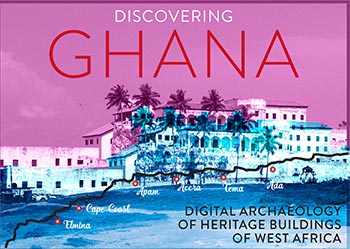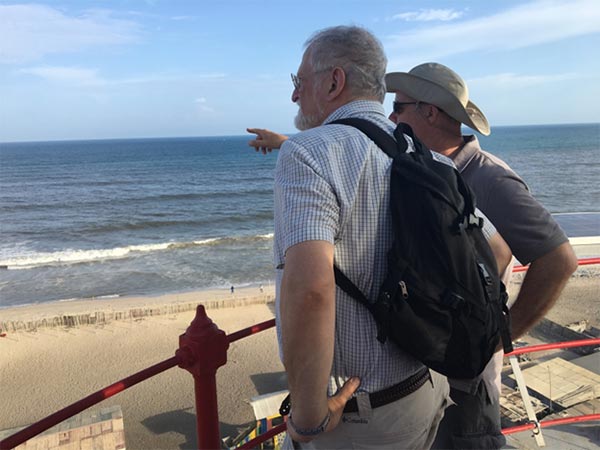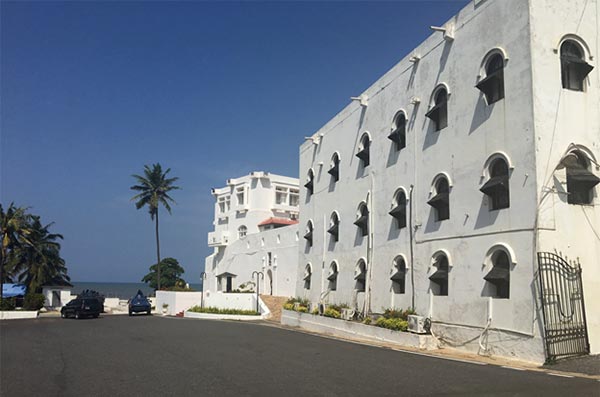
by Tali Flatté ’19
Talk about a whirlwind week of adventure, exploration, discovery—and adaptation! When I staggered out of the Accra airport on Saturday after 30 hours of travel through three different airports, I could not have been more relieved to see Professor Renato Perucchio waiting for me at the gate. One gigantic bottle of water later, and it was nonstop action for a week. Our bus left every morning at 8:30 a.m., and the earliest we returned was 9 p.m. We traipsed after Professor Perucchio, who seems to have boundless energy and enthusiasm that quickly became infectious.
The ride to the hotel my first night in Ghana was punctuated with anecdotes from Professor Perucchio about the ingenuity of the miniature architects and engineers who are responsible for the massive termite and ant hills that line the road through the University of Ghana campus.
I had some stereotypical expectations of what my first trip to an African country would be like, but I could not have been more wrong.
My first full day in Accra was filled with trips to see beautiful buildings on the University of Ghana campus, including:
- a library that was a maze of hidden courtyards and corridors
- the Museum of African Studies
- the administrative building with a parrot-laden clock-tower
- the international center which had hundreds of miniature crests that we’ve now seen all over the city.
We’re forming a compilation of all the crests we see around town (on the church across the street from the hotel, on some chairs inside the Brazilian sector, in the tomb of W.E.B. Du Bois, etc.) to show the full scope of the crests’ meaning and purpose in Ghanaian society.


Watching the sun go down from the hilltop of the administrative building was the perfect ending to that first day.
On our second day, we began our lectures (engineering statics and structural failure) in the morning. We then visited the Du Bois museum and the mausoleum of Dr. Kwame Nkrumah, the first president of Ghana. We stood on the very spot that represents the end of European colonialism in Ghana, and I reflected on the fact that, starting next week, we would be studying the castle that represents the start of European colonialism in Ghana. The Nkrumah mausoleum felt sacred, a place where 60 years of overwhelming feelings of hope and patriotism were palpable in the air. It was a humbling experience, which cast everything I’d seen in the days before, and everything I saw after, in a new light.
Days three and four were dedicated to exploring forts, castles, and a lighthouse. We first went to Fort Ussher, which contained a museum dedicated to slavery and extensive cellblocks that were used for criminals and dissenting politicians alike. We then went to the towering lighthouse on the beach, which required climbing up several flights of stairs and then squeezing through a tiny hole at the very top to get onto the balcony. The view was astonishing. The ocean stretched for miles in every direction, with the shore showing gradient colors of grey, green, and finally blue. Never one to let an opportunity for a lesson go by, the TA for the course, Bill Green, explained the properties of the lenses within the light and Professor Perucchio described what the various forts were used for and how many there were along the coast.



After that, we visited Fort Christiansborg, or Osu Castle, which was the seat of the Ghanaian government for most of its history. It also has oppressively claustrophobic slave dungeons where slaves waiting for transport were kept for two months or more. One of my favorite parts of this field school is that we get to learn about various architectural elements, and then we see them in action immediately afterwards. This type of educational experience makes it possible to fully appreciate both what we’re learning and what we’re seeing.
As awesome as exploring has been, it wouldn’t have been nearly as fun without the people who came with us. I’ve made completely new friends and developed acquaintanceships into friendships. There are frequent “Look at that!” shouts, comments about where we’ve been, and queries about where we’re going next. Our native Ghanaian member, Saba, has been educating us on the customs and values of the local population, as well as teaching us the various faux pas that we might commit. The breakfast/lunch/dinner table is never dull, and everyone is encouraged to participate in the conversation. Our faculty has been fantastic, with each new member bringing their different expertise and ways of looking at the different sights. Bill, despite being teased (almost) mercilessly for falling into a gutter, has been a great sport (always willing to play cards) and helps keep everything running smoothly. I’m very excited to continue on the adventure with this group of amazing people.

 Tali is majoring in Archaeology, Technology and Historical Structures.
Tali is majoring in Archaeology, Technology and Historical Structures.
Eight University of Rochester students are participating in a field school in Ghana this summer, studying historic coastal forts built as early as the 15th century. Led by Professors Renato Perucchio, Michael Jarvis, and Chris Muir and teaching assistant William Green, the students are studying the engineering, historical, and cultural aspects of these structures, visiting other points of interest in Ghana, and sharing their experiences in this blog.

